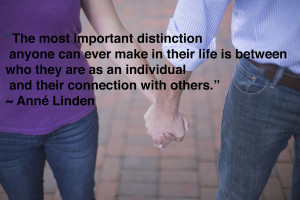Remember the example I gave last time of the classmate who was way too bothered by the way I ate my bagel? That would be an example of overly-permeable boundaries. Not having strong enough boundaries means that your behavior is overly dictated by others.
When parents have a baby, there’s a symbiotic relationship between them and the baby. If they’re functional, the parents are very attuned to the baby’s needs, and their world pretty much revolves around the baby. I woke up twice a night with my sons for (what seemed like) forever, nursed them, rocked them and got them back to sleep. That would be a very permeable boundary – I was letting their needs dictate my behavior, which was appropriate and necessary for healthy infant development.
Now, they’re 10 and 12 years old, and I do not automatically wake up when they do. In fact, if they’re up before me, I have them trained to be pretty quiet and get their own breakfast if I’m sleeping. That boundary has gotten more rigid as they’ve gotten older. Healthy child development means that the boundaries between us become stronger – both they and I have more privacy in our relationship, and they gradually are becoming more independent from me.
Sometimes it’s hard for parents to tolerate the growing boundaries between them and their children. I see unhealthy boundaries between parents and children all the time in my office – parents who expect their child to keep fulfilling them even after the child is grown, or who expect to be able to control their child’s lives well after the child should have control of their own lives. It should be the parent who helps the child develop healthy boundaries, but in these cases the adult child has to, unfortunately, fight against their parent to create healthy boundaries for themselves.

In intimate relationships, it’s also confusing. Boundaries that are too rigid prevent intimacy, but boundaries that are
overly permeable mean that the individuals lose their individuality and become merged. I’m sure we’ve all known at least one couple that seems like they’ve become one entity instead of two separate people. Psychologists tend to think that a healthy relationship lies somewhere in the middle, but what ends up happening in reality is that it’s a dynamic that keeps shifting. Sometimes you’re closer, sometimes you’re a little more distant. Sometimes one partner wants boundaries in one place, and the other partner wants them to be somewhere else. Staying in one extreme for too long is not healthy, because couples need a balance between intimacy and individuality.
Boundaries are also culturally based – cultures can influence what partners share with each other and what remains separate. In the US and Western Europe, we tend to value individuality within a partnership, and individuation from one’s family of origin, more than some other cultures might.
Ultimately, boundaries are very complex, and vary according to situation and history. Trying to find the balance between having intimate relationships, but not being overtaken by someone else’s needs and emotions, is the work of a lifetime.
